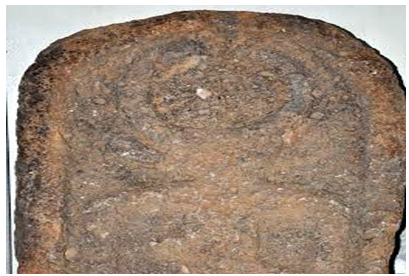It looks like you're using an Ad Blocker.
Please white-list or disable AboveTopSecret.com in your ad-blocking tool.
Thank you.
Some features of ATS will be disabled while you continue to use an ad-blocker.
9
share:
I wonder who really was this "Adad". Ancient weather control?...., what technology he used?
I think he is mentioned in the Bible too, as "Hadad". Somewhere in the Genesis. He got horns too...

sana.sy...
Reference :
www.britannica.com...
I think he is mentioned in the Bible too, as "Hadad". Somewhere in the Genesis. He got horns too...

Sweida, (SANA) The Sweida Antiquities Department said a unique statue of the Aramaic God of Weather, Adad, was found in the village of Aws in Sweida.
In a statement to SANA, Head of the Department Hussein Zein Eddin said that the artifact dates back to the Aramaic era, approximately the 7th century BC, and is the third statue for Adad, adding that the two previous versions are in the National Museum in Damascus and Tal al-Ashaari in Daraa.
The basalt sculpture is 130 cm high and 60 cm wide, adding that the finding came during an expedition in Aws area.
The house where the statue was found was built in 1914. Aws is home to various collections of writings, carvings and antiques from the Nabataean, Aramaic and Islamic periods.
M. Nassr/ H. Said
sana.sy...
Reference :
Adad, weather god of the Babylonian and Assyrian pantheon. The name Adad may have been brought into Mesopotamia toward the end of the 3rd millennium bc by Western (Amorite) Semites. His Sumerian equivalent was Ishkur and the West Semitic was Hadad.
Adad had a twofold aspect, being both the giver and the destroyer of life. His rains caused the land to bear grain and other food for his friends; hence his title Lord of Abundance. His storms and hurricanes, evidences of his anger against his foes, brought darkness, want, and death. Adad’s father was the heaven god Anu, but he is also designated as the son of Bel, Lord of All Lands and god of the atmosphere. His consort was Shalash, which may be a Hurrian name. The symbol of Adad was the cypress, and six was his sacred number. The bull and the lion were sacred to him. In Babylonia, Assyria, and Aleppo in Syria, he was also the god of oracles and divination. Unlike the greater gods, Adad quite possibly had no cult centre peculiar to himself, although he was worshiped in many of the important cities and towns of Mesopotamia, including Babylon and Ashur, the capital of Assyria.
www.britannica.com...
edit on 20-5-2014 by Trueman because: (no reason given)
edit on 20-5-2014
by Trueman because: (no reason given)
Ben-Hadad was an Aramean leader a few thousand years ago. He waged war against ancient Judea.
Ben Hadad wikiwiki
Ben Hadad wikiwiki
edit on 20-5-2014 by dashen because: (no reason given)
Adad was imported to the Sumero-Akkadian empire by Western Semites. To Western Semites his name was Hadad. Abraham's lineage was thought by scholars
to have been among the Western Semites, before becoming ensconced in Sumer as the priestly cult at Nippur.
Horns, in Sumerian depictions, usually indicated a deity.
Horns, in Sumerian depictions, usually indicated a deity.
edit on 20-5-2014 by Blackmarketeer because: (no reason given)
originally posted by: LDragonFire
a reply to: Trueman
Do they have hurricanes in this part of the world?
The weather was different every where in those days, could be. Anyway, he was a god right?
originally posted by: Blackmarketeer
Horns, in Sumerian depictions, usually indicated a deity.
That is exactly right.
The way to tell if you're looking at a diety in Sumerian depiction is to look for the horns.
Sometimes the horns are little projections on a hat of sorts.
Also, "flouncy" looking robes depict dieties.
Harte
new topics
-
Let's talk planes.
General Chit Chat: 7 hours ago -
January 6th report shows disturbing trend (nobody is shocked)
US Political Madness: 8 hours ago -
Inexplicable military simulation - virtual reality showdown in the night..
The Gray Area: 9 hours ago -
The Truth about Migrant Crime in Britain.
Social Issues and Civil Unrest: 10 hours ago
top topics
-
Trudeau Resigns! Breaking
Mainstream News: 12 hours ago, 26 flags -
January 6th report shows disturbing trend (nobody is shocked)
US Political Madness: 8 hours ago, 20 flags -
Live updates: Congress meets to certify Trump's presidential election victory
US Political Madness: 13 hours ago, 12 flags -
The Truth about Migrant Crime in Britain.
Social Issues and Civil Unrest: 10 hours ago, 10 flags -
Gravitic Propulsion--What IF the US and China Really Have it?
General Conspiracies: 13 hours ago, 9 flags -
Let's talk planes.
General Chit Chat: 7 hours ago, 5 flags -
Greatest thing you ever got, or bought?
General Chit Chat: 13 hours ago, 4 flags -
Inexplicable military simulation - virtual reality showdown in the night..
The Gray Area: 9 hours ago, 2 flags
active topics
-
January 6th report shows disturbing trend (nobody is shocked)
US Political Madness • 47 • : RazorV66 -
Judge rules president-elect Donald Trump must be sentenced in 'hush money' trial
US Political Madness • 31 • : JadedGhost -
Gravitic Propulsion--What IF the US and China Really Have it?
General Conspiracies • 16 • : YouSir -
Trudeau Resigns! Breaking
Mainstream News • 65 • : firerescue -
Greatest thing you ever got, or bought?
General Chit Chat • 21 • : rickymouse -
Islam And A Book Of Lies
Religion, Faith, And Theology • 12 • : nugget1 -
Trump says ownership of Greenland 'is an absolute necessity'
Other Current Events • 65 • : BingoMcGoof -
Let's talk planes.
General Chit Chat • 7 • : rickymouse -
Democrats Introduce Bill That Will Take Away Donald Trumps Secret Service Protection
2024 Elections • 77 • : WeMustCare -
OK this is sad but very strange stuff
Paranormal Studies • 8 • : rickymouse
9
